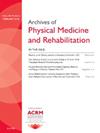Integrative, Mindfulness, Compassion, and Somatic Approach to Treatment of Chronic Pain and Posttraumatic Stress Disorder Among Military Populations with Brain Injury: A Case Series
IF 3.6
2区 医学
Q1 REHABILITATION
Archives of physical medicine and rehabilitation
Pub Date : 2025-04-01
DOI:10.1016/j.apmr.2025.01.074
引用次数: 0
Abstract
Objectives
Military service populations with traumatic brain injury (TBI) report high levels of chronic pain (CP) and posttraumatic stress disorder (PTSD). These comorbid conditions severely impact physical and social functioning, identity, cognition, mood, and performance. Evidence supports the inclusion of mindfulness and compassion in cognitive treatment of co-occurring CP and PTSD, and has also shown positive outcomes from somatosensory approaches targeting this relationship (eg, greater nervous system regulation and embodiment, decreased symptomology). Mental skills training and sport enhancement may enhance these models by promoting enhanced resilience, performance, and strategies for managing the challenges inherent to these conditions. To date, there are no body-centered treatment frameworks that integrate these modalities to target comorbidity among rehabilitation populations. This is the first investigation to examine an integrated clinical model for military service members with TBI and co-occurring CP and PTSD.
Design
A case series featuring mixed methods with pre-post intervention measures and qualitative responses.
Setting
An intensive postacute brain injury inpatient rehabilitation program within a veterans affairs hospital that provides service to active-duty military members.
Participants
Male special operations forces service members (N=3) with TBI, CP, PTSD, other comorbid psychiatric disorders, and neurobehavioral symptoms.
Interventions
Treatment consisted of 3 weeks of 1-hour, 2 × a week acceptance and commitment as well as cognitive behavioral psychotherapy sessions, mindfulness and meditation, self-compassion practices, sport psychology psychoeducation, performance coaching, somatic exercises, mindful movement, experiential practices, and homework.
Main Outcome Measures
Participants completed the GAD-7, PHQ-9, PCL-5, Headache Management and Self-Efficacy Scale, Migraine Disability Assessment, and Neurobehavioral Symptom Inventory. Acceptability and usability were also assessed via open-ended questions.
Results
Participants reported significant decreases in anxiety, depression, PTSD, and neurobehavioral symptoms. They also reported increased, significant ability to manage pain and greater self-efficacy. Results on migraine disability were mixed. Positive changes such as relating more adaptively to self and symptoms, increased self-mastery, and sense of competency in the face of stress were reported.
Conclusions
To our awareness, this is the first evidence to support initial efficacy and acceptability of an individualized, integrative treatment framework for co-occurring PTSD and CP among active-duty service members with TBI. Results are an innovative contribution to the literature, highlighting the possible impactful change in individuals’ ability to effectively manage PTSD symptoms and pain after injury via contemplative, mental performance-based approaches. Recommendations for future investigations, interdisciplinary team consultation and collaboration, as well as trauma-sensitive adaptions are provided.
Disclosures
none.
综合、正念、同情和躯体方法治疗军队脑损伤人群中的慢性疼痛和创伤后应激障碍:一个病例系列
目的:创伤性脑损伤(TBI)军人慢性疼痛(CP)和创伤后应激障碍(PTSD)水平较高。这些合并症严重影响身体和社会功能、身份、认知、情绪和表现。证据支持将正念和同情纳入同时发生的CP和PTSD的认知治疗中,并且也显示了针对这种关系的体感方法的积极结果(例如,更大的神经系统调节和具体化,减少症状)。心理技能训练和运动增强可以通过提高韧性、表现和管理这些条件固有挑战的策略来增强这些模型。迄今为止,还没有以身体为中心的治疗框架,将这些模式结合起来,针对康复人群中的合并症。这是第一次对创伤性脑损伤和合并CP和PTSD的军人进行综合临床模型研究。设计一个案例系列,采用干预前后测量和定性反应的混合方法。在退伍军人事务医院内为现役军人提供服务的急性脑损伤住院患者强化康复计划。参与者:小型特种作战部队服役人员(N=3),患有创伤性脑损伤、CP、PTSD、其他共病精神疾病和神经行为症状。干预治疗包括3周,每周1小时,2次 × ,接受和承诺以及认知行为心理治疗课程,正念和冥想,自我同情练习,运动心理学心理教育,表现指导,躯体练习,正念运动,体验练习和家庭作业。受试者完成了GAD-7、PHQ-9、PCL-5、头痛管理和自我效能量表、偏头痛残疾评估和神经行为症状量表。可接受性和可用性也通过开放式问题进行评估。结果参与者报告焦虑、抑郁、创伤后应激障碍和神经行为症状显著减少。他们还报告说,他们控制疼痛的能力显著增强,自我效能感也增强了。偏头痛致残的结果好坏参半。据报道,积极的变化,如对自我和症状的适应性更强,自我控制能力增强,以及面对压力的能力感。结论:我们认为,这是第一个支持个体化、综合治疗框架对创伤性脑损伤并发PTSD和CP的初步疗效和可接受性的证据。结果是对文献的创新贡献,强调了通过沉思,基于心理表现的方法,在个体有效管理创伤后应激障碍症状和损伤后疼痛的能力方面可能产生的影响变化。建议未来的调查,跨学科的团队咨询和合作,以及创伤敏感的适应。
本文章由计算机程序翻译,如有差异,请以英文原文为准。
求助全文
约1分钟内获得全文
求助全文
来源期刊
CiteScore
6.20
自引率
4.70%
发文量
495
审稿时长
38 days
期刊介绍:
The Archives of Physical Medicine and Rehabilitation publishes original, peer-reviewed research and clinical reports on important trends and developments in physical medicine and rehabilitation and related fields. This international journal brings researchers and clinicians authoritative information on the therapeutic utilization of physical, behavioral and pharmaceutical agents in providing comprehensive care for individuals with chronic illness and disabilities.
Archives began publication in 1920, publishes monthly, and is the official journal of the American Congress of Rehabilitation Medicine. Its papers are cited more often than any other rehabilitation journal.

 求助内容:
求助内容: 应助结果提醒方式:
应助结果提醒方式:


